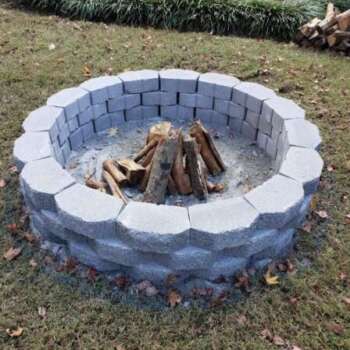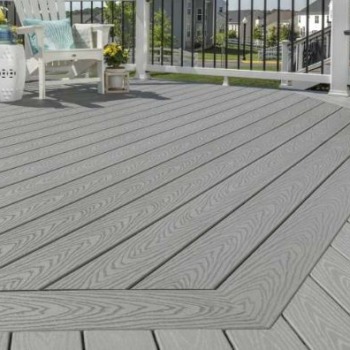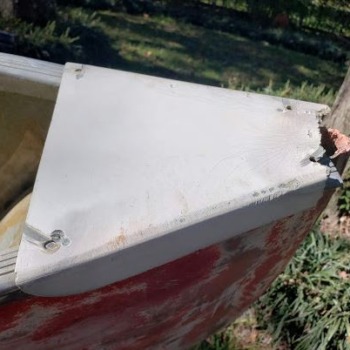We use several different methods to keep our outdoor potted plants watered depending on where the plant is located and the size of the planter. Making self-watering systems really cuts back on the frequency of manual waterings, and improves the amount of water delivered to each plant. No offense intended to some of the other DIY self-watering planter methods suggested out there, but rubbermaid containers, dollar store buckets, and 5 gallon tubs aren’t the look we’re going for if the potted plant is on the porch, deck or anywhere that is meant to be decorative. For those locations, we try to use discrete watering methods that aren’t immediately visible. But for plants out back in the garden or further away from the house or hidden behind other foilage, buckets and tubs are a convenient way to reduce the time we spend watering plants.
Hidden Wicking Water Bucket
If you have a grouping of several potted plants, you could hide a large water reservoir among them without it being too visible. Because you’ll be supplying water to several planters, select a water jug, 2 liter soda bottle, bucket or other container that can hold 2 quarts to 2 gallons of water. We use a 2 liter clear soda bottle.
Cut long 1″ sections of fabric cording, one for each planter. You can get 50 feet of clothesline cording at most stores for around $2. Feed one end of the cord in the water reservoir so it touches the bottom of your bottle or bucket, and insert the other end about 1/3 the way into the soil of a planter. If your cording won’t lay nicely on the bottom of your water reservoir, tie a hexagon bolt or small fishing weight to the end to weigh it down. Repeat this for each additional planter. Fill the water reservoir, and the cording will gradually draw up water and deliver it to the soil of each planter using capillary action.
This works best if your water reservoir (bucket or bottle) sit level with or just below the planters.
Pond Watering
If you have a pond, you already have the perfect water reservoir for your potted plants. We always have potted plants around our small decorative inground pond, and it makes perfect sense to let the pond do all the watering for us. Use either fabric cording or thin strips of felt. Feed the cording about 3-4 inches into your potted plant’s soil and lay the other end of the cording into the pond’s water.
The only problem we’ve run into using this method is the cording is very lightweight and moves around easily, sometimes ending up on the side of the pond (out of the water). To address this, we add small fish weights to the ends of the cording. Another problem we’ve run into is that some of our potted plants are a few feet away from the pond. That means the cording is lying on the ground, which resulted in the water getting drawn into the ground instead of the planter. Enclosing the exposed cording with duct tape and hiding it underneath mulch took care of that problem.
DIY Self-Watering Planter
We wanted to be able to use all the pretty planters and pots we have acquired over the years and convert them into self-watering planters with damaging or having to drill them.
If you’d prefer not to drill holes or modify your planter, all you’ll need to do is get 2 clear plastic planter drip trays in a size matching the bottom of your planter, a section of fiber cording or 1/2 inch strip of felt (the length of your planter plus 3 inches) and some rocks or pebbles.
Start with an empty planter. Place one drip tray on the bottom of the planter and fill the drip tray with rocks or pebbles. Cut a small hole through the bottom of the second drip tray and feed a fiber wick down through the hole until the wick extends out about 3-4 inches. Add a few more holes around the perimeter as drainage for the soil. If your drainage holes are large, you can cover them with coffee filters so that soil doesn’t spill down into the water reservoir.
Set the second tray on top of the rocks/pebbles and position the cord/felt underneath the rocks/pebbles. While holding the excess cording or felt so that it is close to the center of the planter, add your soil. You can now add your plant and water the planter. The excess water will drain into the water reservoir and will be drawn up into the soil as needed. Any excess water will spill out over the trays and naturally drain out of the planter’s drainage holes.
Best used for 8-10 planters with existing drainage holes, and planters that you do not want to modify such as ceramic pots, etc. Provides approximately 8-10 ounces of an additional water source to plants in between normal waterings and rains (depending on size of drip tray).
DIY Self-Watering Planter (Modified)
A concern we had was that many of the DIY self-watering planter designs for outdoor planters don’t address water overflow issues; there is no way for excess water to drain out in the event of heavy rains or over-watering. This modified method works really well for bigger plastic planters in which a deeper water reservoir is needed. There are few extra supplies needed, but this planter will provide a larger amount of water so your plants can go for extended periods without watering.
Because you will be blocking the planter’s existing drainage holes, a new drainage hole will be needed to address overflow in the event of heavy rains or over-watering. You’ll need a heavy sheet of plastic (those black contractor’s trash bags work well, or 4 ml plastic), enough rocks or pebbles to fill 4″ at the bottom of your planter, a double layer of landscape fabric, cording or a strip of felt (slightly longer than the length of your planter), and duct tape.
- Line the bottom of the planter with the plastic so that covers the bottom and comes up the sides about 3 inches.
- Secure the plastic around the inside of the planter using duct tape.
- Cut 3 pieces of cording or felt strips so that they are slightly longer than the length of your planter.
- Secure the cording or felt strips to the inside of your planter using duct tape. With the bottom ends of the cording or felt strips resting on the plastic at the bottom of your planter, secure them to the sides of your planter (space the apart at equal distances). You will be repositioning the top sections of cording or felt later, so the tape at the top is just there to keep them from moving for now.
- Add 4 inches of rocks or pebbles to the bottom of the planter, covering the cording or felt strips.
- Using a half inch drill bit, drill a hole through your planter parallel with the top of your rock line. This new drainage hole will allow water overflow to escape, rather than saturating your soil.
- Now add a double layer of landscape fabric to the bottom of your planter, covering the rocks. Leave an extra 3 inches up the sides of the planter, and secure the landscape fabric into position using duct tape around the inside of the planter.
- Begin adding soil to your planter until about 1/2 full.
- Remove the duct tape from the top section of cording/felt strips. Continue adding soil while trying to get the strips closer to the center of the planter. This will allow water to be drawn closer to the roots of the plant.
- When you are almost done filling the planter with soil, cover any excess sections of cording/felt so that it is under about 1-2 inches of soil.
Now plant your plants and water thoroughly until you see water coming out of the new drainage hole on the side of the planter. You will know when it’s time to water again by checking the saturation of the cording/felt wicks just below the surface of the soil.
This method is ideal for larger plastic planters (10+ inches). Depending on the size of the base of the planter, the water reservoir can hold 1 quart to 2 gallons of water.
Hidden Wicking Water Reservoir
This method is similar to our Water Wicking Soda Bottle, but with a few modifications. Instead of standing next to the planter, the soda bottle is partially buried inside the planter so it won’t be visible once your plants grow.
First, the bottom end of the bottle is removed. Then the entire bottle is planted upside down into the center of the pot, with only a 1/2 inch section of the bottle above the soil level. Like the original Water Wicking Soda Bottle, a fiber wick is fed through a hole in the bottle’s cap to deliver water via capillary action.
This will provide approximately 8-10 ounces of additional water to plants in between waterings and rains.
Best used for larger planters with enough space to accommodate the bottle and the plants, or for hanging planters where other wicking methods aren’t practical.
Gutter Watering System For Hanging Plants
Think of this as a mini gutter rain chain. If you have hanging planters extending out from under your eaves, you can utilize your gutter to deliver water to the planters below.
Feed or hang a line, cording, or chain through a very small (1/8″) hole in the gutter directly above the planter.
This will allow your planters to be watered when ever it rains.
PVC Watering System
This is a lot like the gutter watering system, but works better with smaller potted plants. Again, we hide the whole thing inside a decorative wooden planter.
Double Dollar Store Bucket Watering System
This is a simple way to keep potted plants watered because it only requires two 2 gallon buckets from the dollar store, fabric cording or a strip of felt, and any objects that will raise the inner bucket up 3 1/2 inches (this filler can be broken terracotta pot pieces, rocks, pebbles, wood scraps, etc). You’ll be using one bucket as the container (outer bucket) and the other bucket as the liner (inner bucket). Measure 3.5 inches up the outside of the outer bucket and drill a 1/2 inch hole. This will be the overflow drain. Line the perimeter of the bottom of the outer bucket with your filler up to the drainage hole; avoid putting any filler in the very center of the bucket (this space is where the cord will need to extend into).
Now take your inner bucket and drill a 1/8 inch hole in the bottom center of the bucket. Cut a section of fabric cording to the length of your inner bucket plus 5 additional inches. Feed your cord into the 1/8″ hole until it extends 4″ out of the bottom. Add 4 additional holes around the bottom of your inner bucket for drainage; these should be about 3/8″ to 1/4″ in diameter. Cover these drainage holes with fabric, coffee filters; anything to prevent soil from dripping out.
Set your inner bucket into the outer bucket. While holding up the top end of the cording, fill your bucket with soil and then add your plant. You can trim off any exposed cording or just tuck it underneath the soil so it is not visible. Drench the soil until you see water coming out of the overflow drain on the side.
Capillary Matting
If you have a lot of potted plants in one area, especially in 1 gallon or smaller sizes, you might benefit from using a capillary matting system to keep them watered. In addition to all the vegetable beds in our garden we have a lot of potted herbs, as well as other plants waiting to be planted once they grow in size. To keep all these planters consistently watered we use capillary matting. Because these pots are small, they tend to dry out faster and would otherwise require watering twice a day. Capillary matting is easy to set up. All you need are heavy duty contractor trash bags, long strips of fabric felt, and a small tub as a water reservoir (litter box size).
Cut the trash bags into 18″ strips and lay them directly on the ground so that they extend the full length of your potted plants, plus a few feet needed to reach your watering tub. Cut 10″ wide strips of fabric felting and lay them centered directly onto the plastic bag strips, overlapping the felt strips by 6″ if needed. Extend one end of your felt long enough to completely lay inside the watering tub. Wet down the felt and set your potted plants onto the felt. Then lay pieces of the trash bags over the exposed strips of felt in between the planters. This will help reduce the amount of water lost due to evaporation. Fill your watering tub with water and the felt will draw up water as needed.
The other really nice benefit to using capillary matting in the garden is that the plastic underneath the felt prevents weeds and grasses from growing around the planters.



![[Automatic Plant Watering Kit] It's powered by solar energy, can take water directly from containers such as buckets, without the need for a tap. It can automatically water your plants at preset time intervals and amounts, and will automatically alar...](https://m.media-amazon.com/images/I/41sOB772npL._SL160_.jpg)




